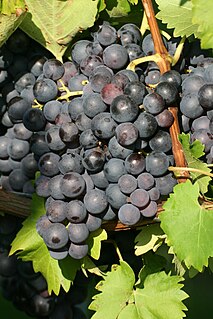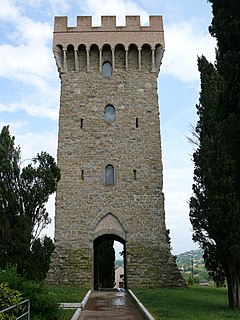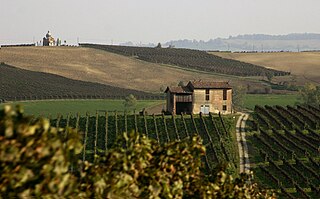
The Piave is a river in northern Italy. It begins in the Alps and flows southeast for 220 kilometres (140 mi) into the Adriatic Sea near the city of Venice. One of its tributaries is the Boite.

Trollinger, Schiava, or Vernatsch, is a red German/Italian wine grape variety that was likely first originally cultivated in the wine regions of South Tyrol and Trentino, but today is almost exclusively cultivated on steep, sunny locations in the Württemberg wine region of Baden-Württemberg. It is primarily known under the synonyms Trollinger in Germany, Vernatsch in South Tyrol and Schiava in other Italian regions. As a table grape the variety is sometimes known as Black Hamburg, which is commonly confused with the similar synonym for Black Muscat—a variety that is actually a cross of Trollinger and Muscat of Alexandria.

Controguerra is a town and comune in Teramo province in the Abruzzo region of central Italy.

Lizzano is a comune of 10,175 inhabitants (2013) in the province of Taranto in the Apulia region of southeast Italy.

Capalbio is a comune (municipality) in the Province of Grosseto in Tuscany region of Italy, located about 150 kilometres (93 mi) south of Florence and about 45 kilometres (28 mi) southeast of Grosseto. Capalbio borders the following municipalities: Manciano, Montalto di Castro, Orbetello.

Torgiano is a comune (municipality) in the Province of Perugia in the Italian region Umbria, located about 10 km southeast of Perugia.
Pineau d'Aunis is a red French wine grape variety that is grown primarily in the Loire Valley around Anjou and Touraine.

Montepulciano is a red Italian wine grape variety that is most noted for being the primary grape behind the DOCG wines Offida Rosso, Montepulciano d'Abruzzo, Montepulciano d'Abruzzo Colline Teramane, Rosso Conero and the DOC wine Rosso Piceno Superiore.

Friuli-Venezia Giulia wine is wine made in the northeastern Italian region of Friuli-Venezia Giulia. Once part of the Venetian Republic and with sections under the influence of the Austro-Hungarian Empire for some time, the wines of the region have noticeable Slavic and Germanic influences. There are 11 Denominazione di origine controllata (DOC) and 3 Denominazione di Origine Controllata e Garantita (DOCG) in the Friuli-Venezia Giulia area. The region has 3 Indicazione Geografica Tipica (IGT) designations Alto Livenza, delle Venezie and Venezia Giulia. Nearly 62% of the wine produced in the region falls under a DOC designation. The area is known predominantly for its white wines which are considered some of the best examples of Italian wine in that style. Along with the Veneto and Trentino-Alto Adige/Südtirol, the Friuli-Venezia Giulia forms the Tre Venezie wine region which ranks with Tuscany and Piedmont as Italy's world class wine regions.
Verduzzo is a white Italian wine grape grown predominantly in the Friuli-Venezia Giulia region of northeast Italy. It is also found in significant plantings in the Piave Denominazione di origine controllata (DOC) of the Veneto region, though some of these plantings may be of the separate Verduzzo Trevigiano variety. Verduzzo Friulano is used in varietal and blended wines, many of which fall under DOC as well as vino da tavola designations, that range in style from dry to late harvest wines. According to wine expert Oz Clarke, most of the sweeter examples of Verduzzo can be found in the Friuli-Venezia Giulia with the grape being used for progressively drier styles of the wine the further west into the Veneto.
Bombino bianco is a white Italian wine grape variety planted primarily along Italy's Adriatic coast line, most notably in Apulia. The vine is prone to high yields and often produces neutral flavor wines. The grape is known under many synonyms throughout Italy including Debit and Pagadebit, names which came from the grape's reputation for being a high yielding and reliable crop for vineyard owners to grow that would assure them that on each vintage they could pay off their debts.

Vespaiola is a white Italian wine grape variety planted primarily in the Veneto region of northeastern Italy, where it is often dried to produce passito style dessert wines. Along with Friulano, Vespaiola is an important component in the Denominazione di origine controllata (DOC) white wine of Breganze produced in the province of Vicenza.
Perricone is a red Italian wine grape variety that is grown in Sicily. In the late 20th century there was around 1000 hectares/2,500 acres of the grape planted throughout the island. According to wine expert Oz Clarke in Sicily Perricone is used to make full bodied, deeply colored, highly alcoholic wines.

The Colli Piacentini is an Italian wine region located at the western end of Emilia-Romagna. In 1967, it was given the Denominazione di origine controllata (DOC) quality designation. Within its boundaries are several smaller DOCs including Colli Piacentini Gutturnio, Monterosso Val D'Arda DOC, Trebbianino Val Trebbia DOC and Val Nur del Colli Piacentini DOC. The region has a long history of winemaking with fossilized vine roots and grape seeds excavated from the region showing viticulture taking place as early as 2000 BC. In Roman times, Julius Caesar's father-in-law Lucius Calpurnius Piso Caesoninus, grew grapes in the Piacenza hills.

Incrocio Manzoni or Manzoni grapes is a family of grape varieties named after Professor Luigi Manzoni (1888-1968) of Italy's oldest school of oenology located in Conegliano, in the Veneto region. Manzoni created the new grape varieties by selecting, crossing and grafting vines from various vineyards during the 1920s and 1930s. The family includes both white and red grape varieties. Although most Manzonis are grown in northeastern Italy, they are mainly grown in the Piave area of Province of Treviso and are only now starting to be sold commercially in Europe and the United States.
Pomino is a village belongs to the municipality of Rufina, in the province of Florence, region Tuscany. The village of Pomino is 7,36 kilometers far from the same town of Rufina to whom it belongs. The locality of Pomino rises 585 meters above sea level and the population counts 228 inhabitants.
Ortrugo is a white Italian wine grape variety that is grown in the Piacenza hills of the Emilia-Romagna region of north central Italy. Here the grape is often blended with Malvasia in the DOC white wines of the area. According to wine expert Oz Clarke, the grape has moderate acidity with high alcohol potential and often contributes a deep yellow color to the wine. In some regions the grape is used in slightly sparkling frizzante and fully sparkling spumante wines.

Nosiola is a white Italian wine grape variety that is grown in the Trentino region north of Lake Garda in the Valle dei Laghi. Here it is used in varietal Denominazione di origine controllata (DOC) wines and as a blending component in wines such as Sorni Bianco from Trento. It is also used to produce a dessert wine in the Vin Santo style from grapes that have been allowed to dry out prior to fermentation.
Negrara is a red Italian wine grape variety grown in north east Italy including the Veneto region where it is a permitted variety in the Denominazione di origine controllata (DOC) wine Amarone. While the grape was once more widely planted in the region its numbers have been steadily declining for most of the late 20th and early 21st century.

Abruzzo (Abruzzi) is an Italian wine region located in the mountainous central Italian region of Abruzzo along the Adriatic Sea. It is bordered by the Molise wine region to the south, Marche to the north and Lazio to the west. Abruzzo's rugged terrain, 65% of which is mountainous, help to isolate the region from the winemaking influence of the ancient Romans and Etruscans in Tuscany but the area has had a long history of wine production.















